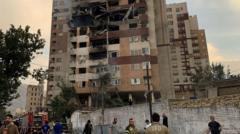As the humanitarian situation in Gaza deteriorates, the World Food Programme has sent aid trucks that are quickly overwhelmed by desperate civilians. Despite a partial lifting of the blockade, the aid provided is insufficient to meet the critical needs of the population facing the threat of famine, while the ongoing Israeli military operations exacerbate the crisis.
Humanitarian Crisis in Gaza: Aid Trucks Rush Amid Chaos and Desperation

Humanitarian Crisis in Gaza: Aid Trucks Rush Amid Chaos and Desperation
The World Food Programme reports frenzied scenes as civilians in Gaza seize aid trucks amidst an ongoing humanitarian crisis marked by hunger and desperation.
In the midst of an escalating humanitarian crisis, chaotic scenes unfolded in Gaza as desperate civilians rushed aid trucks sent by the World Food Programme (WFP). Reports indicate that an overnight convoy of 77 trucks carrying essential supplies, particularly flour, arrived in the region but was met with overwhelming demand from hungry residents trying to feed their families.
WFP spokesperson Abeer Etefa revealed that amid fears the aid would not reach distribution points due to rampant chaos, authorities decided to allow people to take what they could from the trucks. The situation was worsened by the fact that the UN reported that since an 11-week blockade was partially lifted on May 19, only a fraction, approximately 10%, of the necessary aid has actually been delivered to the staggering population in need.
Ms. Etefa described the civilians gathered around the trucks as “the desperate ones who cannot wait to get to distribution points,” stressing that WFP selected distribution routes that prioritized safety and proximity to affected populations. WFP warned that “after nearly 80 days of a total blockade, starving people will not let a food truck pass.”
The United Nations has characterized the situation in Gaza as critical, with estimates suggesting that at least two million residents are in dire need of food. While the Israeli government justified the blockade as a method of pressuring Hamas for the release of hostages, the volume of aid received in recent weeks has been described as woefully inadequate by humanitarian leaders.
Philippe Lazzarini, head of the UN Palestinian relief agency, criticized the current aid efforts as a “mockery” of the dire humanitarian crisis. On social media, the Israeli military's Coordination of Government Activities in the Territories (Cogat) called out the UN for their alleged failure to efficiently distribute the aid already situated in Gaza, claiming that hundreds of trucks remain unutilized.
In an alternative response to the crisis, a US and Israel-supported organization has begun its own food distribution initiative, despite the UN's refusal to partner with them on ethical grounds, citing potential violations of humanitarian principles. Their operations have reportedly served millions of meals, although independent verification of these claims remains unavailable.
Violence continues to plague the region, as Israeli airstrikes persist across Gaza. The Israeli Defense Forces stated that they targeted numerous “terror sites” as part of the ongoing military campaign in response to a deadly Hamas attack on October 7, which left about 1,200 people dead and many more kidnapped. As the humanitarian and security situation spirals further into chaos, medical professionals in Gaza express concerns over widespread malnutrition, particularly among children, which is severely impeding recovery outcomes for trauma patients.
Compounding this crisis, a planned visit by foreign ministers from several Arab states to the West Bank has been blocked by Israeli authorities, leading to further tensions in a region that remains on edge. With a significant international conference hinted at in the near future to discuss a potential two-state solution, the immediate needs of Gaza's population remain urgent, highlighting the stark realities faced by millions caught in the turmoil.





















